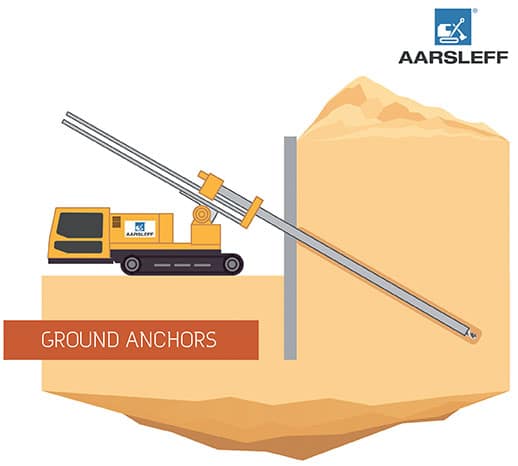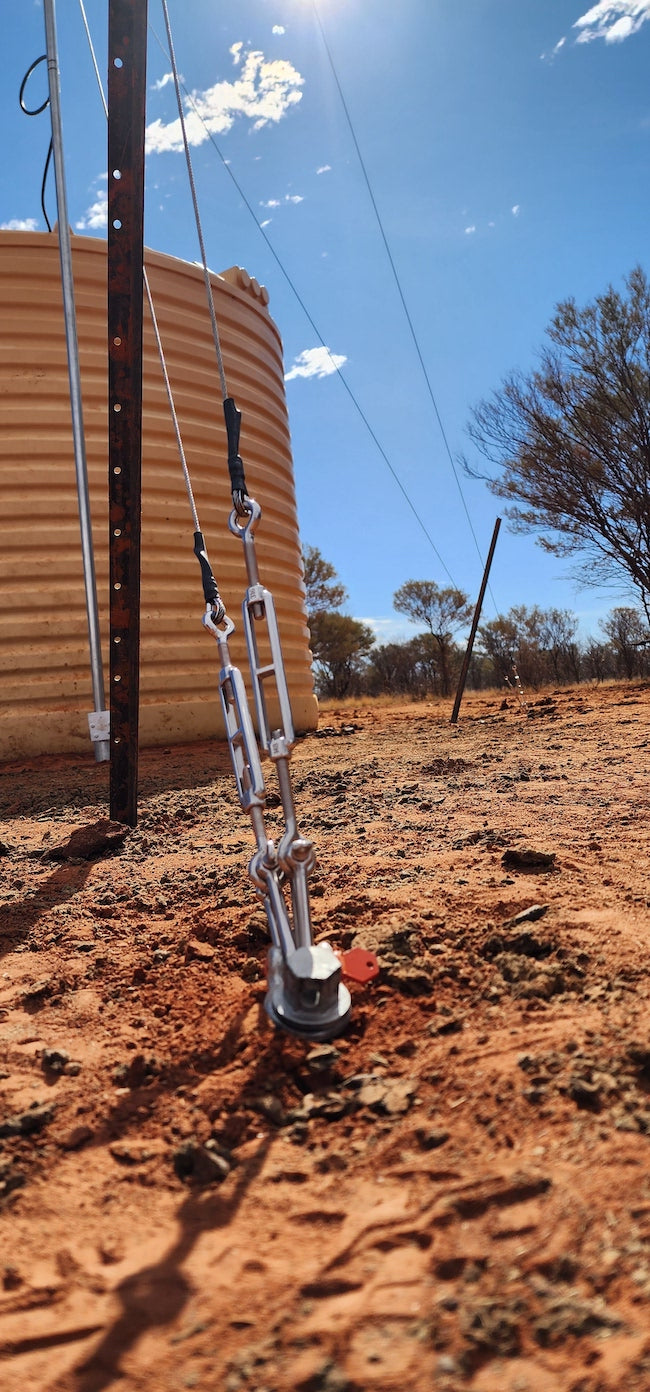Major Benefits Offered by construction site anchors in Urban Environments
Wiki Article
How Sturdy Earth Anchors Work: A Comprehensive Guide to Soil Anchoring Solutions
Heavy-duty Earth anchors play an essential function in providing stability and assistance in various building and construction applications. By embedding deeply into the ground, they stand up to lateral and vertical forces effectively. Different kinds of anchors provide to different soil problems, making them versatile. Comprehending their mechanics and installment techniques is vital for making the most of performance. What aspects influence their efficiency, and how do they contrast to typical methods? The solutions might stun you.Recognizing Durable Earth Anchors
Sturdy Earth anchors offer as essential components in different construction and landscape design projects, supplying stability and assistance in difficult soil problems. These supports function by being installed right into the ground, where they withstand side and vertical pressures. Their style permits safe accessory to frameworks, ensuring they remain anchored against dirt activity or exterior loads.The efficiency of durable Earth anchors greatly depends on the type of dirt and the support's installation deepness. Proper installment techniques are critical, as they figure out the support's holding capacity. Environmental factors, such as moisture and freeze-thaw cycles, can likewise impact performance.These anchors are frequently used in applications ranging from safeguarding fencings and maintaining walls to maintaining temporary frameworks throughout unfavorable weather. Recognizing the concepts behind durable Earth supports is crucial for professionals looking for to boost the resilience and safety of their jobs.Kinds Of Heavy-Duty Earth Anchors
Different kinds of sturdy Earth anchors are made to meet certain requirements based upon soil problems and task requirements. Helical anchors, including screw-like blades, work in softer dirts, supplying high lots abilities and easy installment. Driven anchors, which are inculcated the ground, appropriate for rough surfaces and give instant load support. Tie-back anchors are frequently used in maintaining wall surface applications, permitting lateral support by anchoring right into the ground at an angle. One more type is the cast-in-place anchor, suitable for concrete applications, as they are integrated into foundations for enhanced stability. Dirt screw supports are flexible alternatives that can be used in different dirt kinds, supplying trustworthy tension and compression abilities. Each type serves distinct applications, ensuring security and safety and security in building and construction and landscaping tasks. Recognizing these options enables educated choices in picking the suitable Earth securing solution.The Mechanics of Soil Anchoring

Recognizing the technicians of soil anchoring requires an evaluation of different kinds of Earth supports and their installation techniques. Each support kind presents one-of-a-kind features that affect its performance in different dirt problems. Proper installment methods are important for maximizing the anchoring system's security and efficiency.
Kinds Of Earth Anchors
Earth anchors, necessary parts in soil anchoring systems, been available in a number of kinds, each made for details applications and soil conditions. The most usual types include screw anchors, which are twisted into the ground, giving strong lateral resistance. Helical anchors feature blades that allow for effective installation in different dirt types, making them suitable for both temporary and long-term applications. Driven anchors, generally made from steel, are inculcated the soil and work in rough or dense settings. Auger anchors utilize a helical design to facilitate setup in softer dirts. Plate anchors consist of a level plate buried flat, distributing lots over a bigger location, ideal for applications calling for high tons abilities in cohesive soils.Installment Methods Discussed
Correct setup techniques are essential for the effectiveness of soil anchoring systems. The process generally starts with website analysis, verifying the selected location can sustain the support's tons. After figuring out the correct support kind, correct hole depth and angle must be established. The installation entails driving the support into the ground utilizing customized tools, such as hydraulic or manual chauffeurs, to accomplish best embedment. Post-installation, tensioning the support is important to guarantee security; this is often validated with load testing. Additionally, surrounding dirt problems need to be monitored to stop variation. Following these techniques not just boosts the anchor's performance but additionally prolongs its life expectancy, providing trusted support for numerous applications.Applications of Heavy-Duty Earth Anchors
While heavy-duty Earth anchors are typically connected with construction and landscape design, their flexibility expands to a selection of applications across various industries. In civil engineering, they give necessary support for preserving walls, guaranteeing stability in areas susceptible to dirt erosion. The marine market uses these supports for securing docks and marinas, stopping movement brought on by tides and currents. Furthermore, in the telecommunications industry, heavy-duty Earth anchors are significant for supporting cell towers and various other high structures versus wind pressures. Agricultural applications additionally benefit, as these supports can secure structures like greenhouses and animals fencing, view it now ensuring they endure extreme weather. In addition, in renewable resource jobs, such as wind ranches, Earth supports play a crucial role in protecting turbine structures, improving total safety and security and efficiency. This broad variety of applications highlights the flexibility and reliability of durable Earth supports throughout various fields.Benefits Over Conventional Anchoring Techniques
Although typical anchoring methods have long been trusted for security, sturdy Earth supports offer significant benefits that boost efficiency and efficiency. One significant benefit is their remarkable load-bearing ability, which enables them to withstand better forces without failing. This toughness makes them optimal for requiring applications, such as in construction and energy installations.Additionally, durable Earth supports are made for much deeper installation, offering higher stability in various dirt conditions, consisting of loosened or sandy dirts. Their resistance to rust and ecological aspects assures a longer life-span and decreased upkeep prices compared to traditional methods.Moreover, these anchors can be installed with very little disturbance to the surrounding area, maintaining the integrity of the landscape. Generally, heavy-duty Earth supports offer a reliable and reliable remedy for securing requirements, exceeding the restrictions frequently linked with conventional anchoring techniques.Setup Process and Best Practices
The setup process for dirt anchoring solutions begins with thorough preparation and site evaluation to assure peak efficiency. Following this, a step-by-step installment guide offers clear directions for reliable application (tensile load hop over to here anchors). Abiding by these ideal practices is vital for attaining lasting and dependable anchoring outcomesPrep Work and Site Evaluation
Efficient prep work and comprehensive site analysis are essential action in the installment of soil securing services. Before installation, the soil kind have to be examined to establish its bearing capability and viability for securing. Conducting a geotechnical study can offer important information about dirt structure, dampness levels, and potential ground movement. Additionally, determining existing structures, plants, and energies is necessary to stay clear of interference throughout installation. The area needs to be cleared of debris and challenges to guarantee secure access for equipment. Weather need to also be kept track of, as unfavorable problems can impact both safety and setup efficiency. By diligently preparing the site and reviewing all relevant elements, the possibility of successful anchor performance is significantly raised.Step-by-Step Installment Guide
A thorough setup process is essential for accomplishing optimal performance of dirt securing remedies. The installment starts with picking the ideal support kind and assuring the website is free from debris. Next off, proper opening placement is determined based on tons demands. As soon as the location is established, holes are drilled to the specified depth and diameter making use of the correct tools. The anchor is then put right into the opening, making certain it is lined up appropriately. After safeguarding the support, dirt is backfilled and compacted to boost stability. It is vital to comply with maker guidelines throughout the procedure. A post-installation examination verifies that the supports are sufficiently positioned and working as planned, providing trustworthy assistance for the designated application.
Maintenance and Assessment of Earth Anchors
Routine maintenance and examination of Earth supports are important for guaranteeing long-lasting efficiency and stability. Periodic checks allow for the early discovery of concerns such as rust, loosening, or dirt movement. Inspectors must look for indicators of corrosion or degradation on the support parts, especially at the connection points. Additionally, the surrounding soil ought to be analyzed for erosion or changes in moisture content, which can influence support effectiveness.It is a good idea to develop a regular assessment routine, ideally at the very least yearly, depending upon ecological conditions. During examinations, all noticeable parts need to be cleansed to remove dirt or debris that could conceal potential troubles. Any type of indications of distress, such as turning structures or unusual settling, ought to motivate immediate evaluation. Proper documentation of assessments can aid in tracking support performance in time and facilitate timely upkeep activities, guaranteeing the anchors stay useful and reputable.Frequently Asked Inquiries
What Products Are Heavy-Duty Earth Anchors Typically Made From?
Sturdy Earth anchors are typically created from long lasting materials such as galvanized steel or stainless-steel, guaranteeing stamina and resistance to deterioration. These materials give durable assistance and stability in numerous dirt conditions and applications.How Do Soil Problems Affect Support Efficiency?
Dirt conditions significantly influence support efficiency. Factors such as dirt kind, moisture material, and compaction affect the support's hold and security, with natural soils commonly providing far better resistance than sandy or loose soils, affecting overall performance.
Can Heavy-Duty Earth Anchors Be Reused After Elimination?
Heavy-duty Earth anchors can be reused after removal, offered they are checked for damage and wear. Appropriate cleansing and maintenance enhance their longevity, guaranteeing reliable performance in subsequent setups when problems enable for safe reinstallation.What Are the Ecological Effects of Using Earth Anchors?
The environmental impacts of making use of Earth supports include prospective soil disturbance, disruption of regional environments, and possible contamination of groundwater. Nevertheless, if utilized sensibly, their benefits commonly outweigh these worries, promoting stability in different applications.How Do I Pick the Right Support for My Task?

Report this wiki page